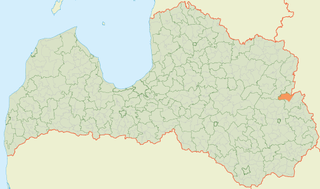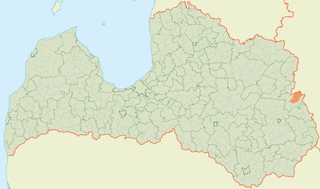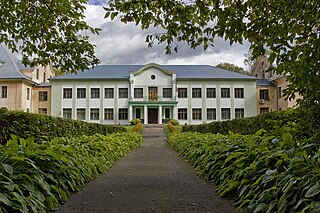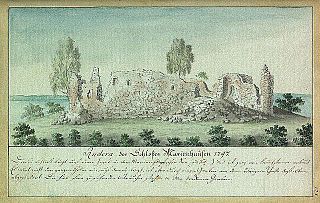
Ludza is a town in the Latgale region of eastern Latvia. Ludza is the oldest town in Latvia and this is commemorated by a key in its coat of arms. Ludza is the administrative centre of Ludza Municipality that is located nearby the Russian border. The population as of 2020 was 7,667.

Dagda is a town in Dagda Parish, Krāslava Municipality in the Latgale region of Latvia, near the country's border with Belarus. It is the administrative center of Dagda Parish.

Kārsava is a town in Ludza Municipality in the Latgale region of Latvia, near the border of Russia.

Ozolnieki Municipality is a former municipality in Semigallia, Latvia. The municipality was formed in 2003 by merging Ozolnieki Parish and Cena Parish; the administrative centre was Ozolnieki. In 2009 it absorbed Sidrabene parish of the former Jelgava District. The population in 2020 was 10,019.

Zilupe Municipality is a former municipality in the historical region of Latgale, and the Latgale Planning Region in Latvia. The municipality was formed in 2002 by merging Zaļesje Parish and Zilupe. In 2009 it absorbed Lauderi Parish and Pasiene Parish, the administrative centre being Zilupe. Zilupe, Lauderi, Zaļesje and Pasiene are among the towns and villages located in the municipality. The population as of 2020 was 2,575.

Salnava Parish is an administrative unit of Ludza Municipality in the Latgale region of Latvia. Prior to the 2009 administrative reforms it was part of the former Ludza District.

Malnava Parish is an administrative territorial entity of Ludza Municipality in the Latgale region of Latvia. Prior to the 2009 administrative reforms it was part of the former Ludza District.

Preiļi Palace is a palace near the town of Preiļi in the historical region of Latgale, in eastern Latvia. Originally built in the early 19th century, the structure was converted between 1860 and 1865 into its present English Neo-Gothic form, also called Tudor style. The interior was destroyed in a February 1978 fire. In 2017, restoration of the Preiļi Palace started, it is planned to place the exposition of the Preiļi History and Applied Art Museum there.

Eversmuiža Manor is a manor in the Cibla Parish of Ludza Municipality in the Latgale region of Latvia.

Jasmuiža Manor is a manor in Aizkalne Parish, Preiļi Municipality in the historical region of Latgale, in Latvia, currently a writer's home museum dedicated to Rainis.

Malnava Manor is a manor in Malnava Parish, Ludza Municipality in the Latgale region of Latvia.

Pasiene Manor is a manor in Pasiene Parish, Ludza Municipality in the historical region of Latgale, in Latvia.

Salnava Manor is a manor in Salnava Parish, Ludza Municipality in the Latgale region of Latvia. Presently Salnava Manor house is used as school building.

Kārsava Municipality is a former municipality in Latgale, Latvia. The municipality was formed in 2009 by merging Goliševa Parish, Malnava Parish, Mērdzene Parish, Mežvidi Parish, Salnava Parish and Kārsava town, the administrative centre being Kārsava.

Ludza Municipality is a municipality in Latgale, Latvia. The municipality was formed in 2009 by merging Briģi Parish, Cirma Parish, Isnauda Parish, Istra Parish, Nirza Parish, Ņukši Parish, Pilda Parish, Pureņi Parish, Rundēni Parish and Ludza town, the administrative centre being Ludza.

Viļaka Castle is a ruined castle in Balvi Municipality in the Latgale region of Latvia. The castle is located close to the town of Viļaka, on the only (unnamed) island in Viļaka Lake.

Vaiņode is a village in Vaiņode Parish, South Kurzeme Municipality in the Courland region of Latvia. The village developed around a railway station after 1871 between Liepāja and Mažeikiai.

The New Unity is a centre-right political alliance in Latvia. Its members are Unity and four other regional parties, and it is orientated towards liberal-conservatism and liberalism.

Krāslava New Palace or Plater's Palace is located in the historical region of Latgale, in eastern Latvia. It is an 18th-century manor ensemble with main manor house and other manor buildings and a Baroque-style park.

Augšdaugava Municipality is one of the 35 municipalities established in Latvia in 2021. It surrounds the independent city of Daugavpils and its municipal headquarters are located there. Its first elected municipal council has taken office on 1 July 2021.






















